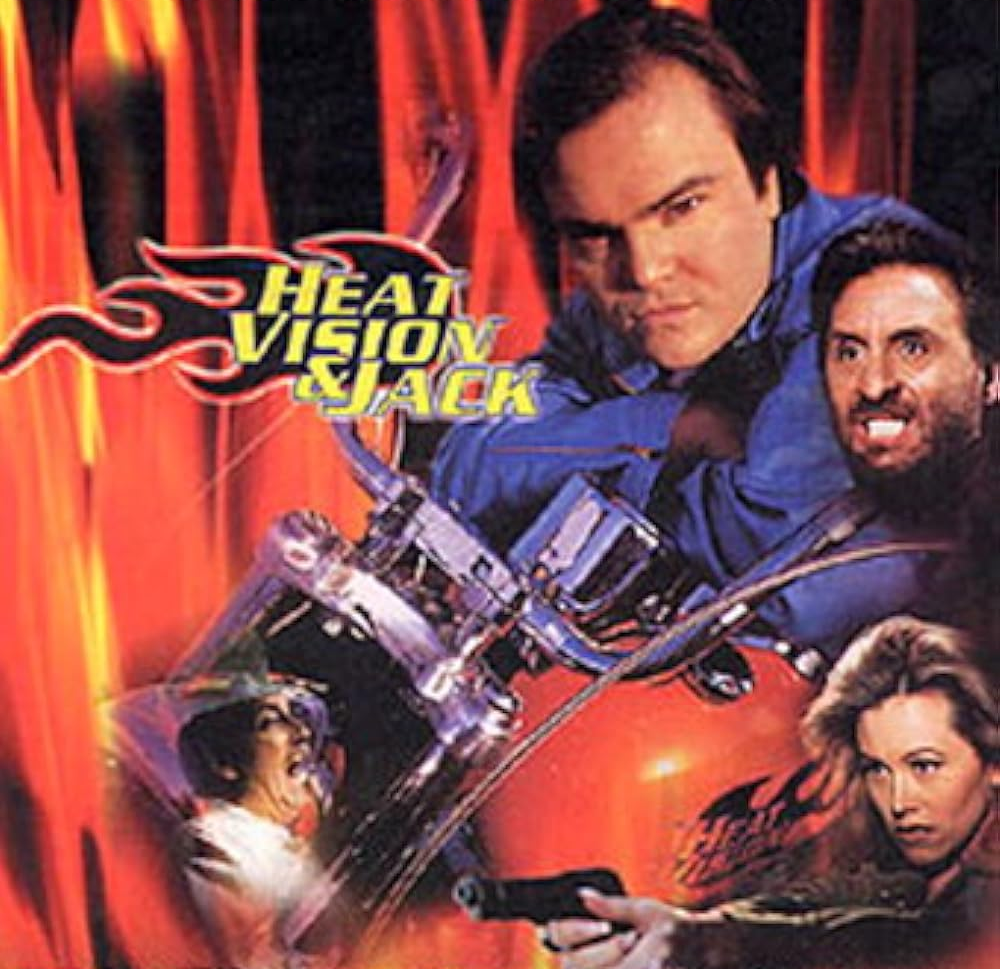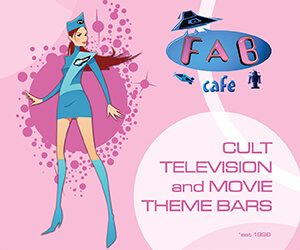Ah, telephemera… those shows whose stay with us was tantalisingly brief, snatched away before their time, and sometimes with good cause. They hit the schedules alongside established shows, hoping for a long run, but it’s not always to be, and for every Street Hawk there’s two Manimals. But here at STARBURST we celebrate their existence and mourn their departure, drilling down into the new season’s entertainment with equal opportunities square eyes… these are The Telephemera Years!
1999-2000
As US TV moved into the twenty-first century, the schedule was full of comings and goings. Sure, old reliables like ER, Friends, Frasier, and Touched by an Angel could be relied upon to bring in millions of viewers for NBC and CBS, but everyone was talking about the new kids on the block. ABC took the top three slots in the ratings with the thrice-weekly Who Wants to Be a Millionaire?, while CBS jumped into the reality market with two feet, debuting both Big Brother and Survivor to an America hungry for average Joes. Also arriving on the network schedules was Judging Amy, Malcolm in the Middle, Law & Order: SVU, and The West Wing, while HBO debuted The Sopranos.
For genre fans, Buffy spin-off Angel premiered on The WB, as did UFO drama Roswell, and Relic Hunter, The Lost World, and Beastmaster are began syndicated runs. This made up for the loss of Sliders and Poltergeist: The Legacy, both of which were entering their final seasons, along with Boy Meets World, Chicago Hope, Beverly Hills 90210, Party of Five, and Veronica’s Closet. At least those shows made it to screen in a crowded market where many fell before the first hurdle: this is the story of 1999’s unsold pilots…
Manchester Prep (Fox): Riding high on the insane popularity of Buffy the Vampire Slayer, Sarah Michelle Gellar was very much in demand in the late-1990s and in 1999 she led a group of attractive young things in Cruel Intentions, a sexy, school-based adaptation of Les Liaisons Dangereuses that upped the taboo ante by including some step-incest. Ryan Philippe, Reece Witherspoon, and recently wrong-headed Selma Blair completed a cast that brought in seven times the movie’s budget at the box office, enough of a success that a direct-to-video sequel appeared a year later.
That wasn’t always the plan, though, and the sequel’s origins lie in a proposed TV series for Fox. Entitled Manchester Prep for the hoity-toity school attended by the movie’s young ingenues, it was the brainchild of writer-director Roger Kumble, an award-winning playwright who’d shepherded the original to the screen. Kumble was the only returnee from the movie, Fox’s TV budget unable to stretch to Gellar, Philippe, Witherspoon, or even Blair, and their parts were given to a new array of teen hopefuls, intending to repeat the successful formula of the year before.

A prequel set as Sebastian Valmont (with Robin Dunne of gender-swapped Canadian show Little Men replacing Philippe) is introduced to his new school and his wicked stepsister, Kathryn (newcomer Amy Adams), Kumble’s pitch included a number of new characters to further the intrigues of the blended Valmont-Merteuil siblings. Kathryn is clearly the villain of the piece once more, this time aiming her bile at new student Cherie (Keri Lynn Pratt) and the headmaster’s daughter, Danielle, also the object of Sebastian’s desire, again played by a newcomer in the shape of Sarah Thompson.
Quite how Kumble would have stretched the premise over a full series (and presumably beyond) is anyone’s guess, but you might take clues from how Gossip Girl, also set amongst the privileged Upper Manhattan school set, turned out. Regardless, Fox passed on a series and the pilot was rushed out as a DTV prequel to the original even as that movie was hitting rental stores. Kumble returned with Cameron Diaz, Christina Applegate, and – yes- Selma Blair in 2002’s The Sweetest Thing and has made quirky romcoms his stock in trade ever since.
Battlestar Galactica: The Second Coming: Galactica 1980, the Earthbound sequel to the original Battlestar Galactica TV series has its fans, despite its second-rate cast and continuity shattering setting, but Richard Hatch – Apollo in the original run – clearly wasn’t one of them. In the late 1990s, Hatch decided it was time to get the band back together and pitch a sequel to Universal, one that took up exactly where the original left off some twenty years before, making the events of Galactica 1980 non-canon.
Although Lorne Greene had died in 1987, Maren Jensen had long retired, and Dirk Benedict presumably wasn’t returning Hatch’s calls, Hatch managed to get much of the original cast back on board, with John Colicos’s Baltar and Terry Carter’s Colonel Tigh – now President of the Council of Twelve – lending some heavyweight fan appeal to the project. Hatch, of course, returned as Apollo but the role of Starbuck was not recast in Benedict’s absence, instead being retooled as Starbuck’s feisty daughter (and presumable love interest for a grown-up Boxey).
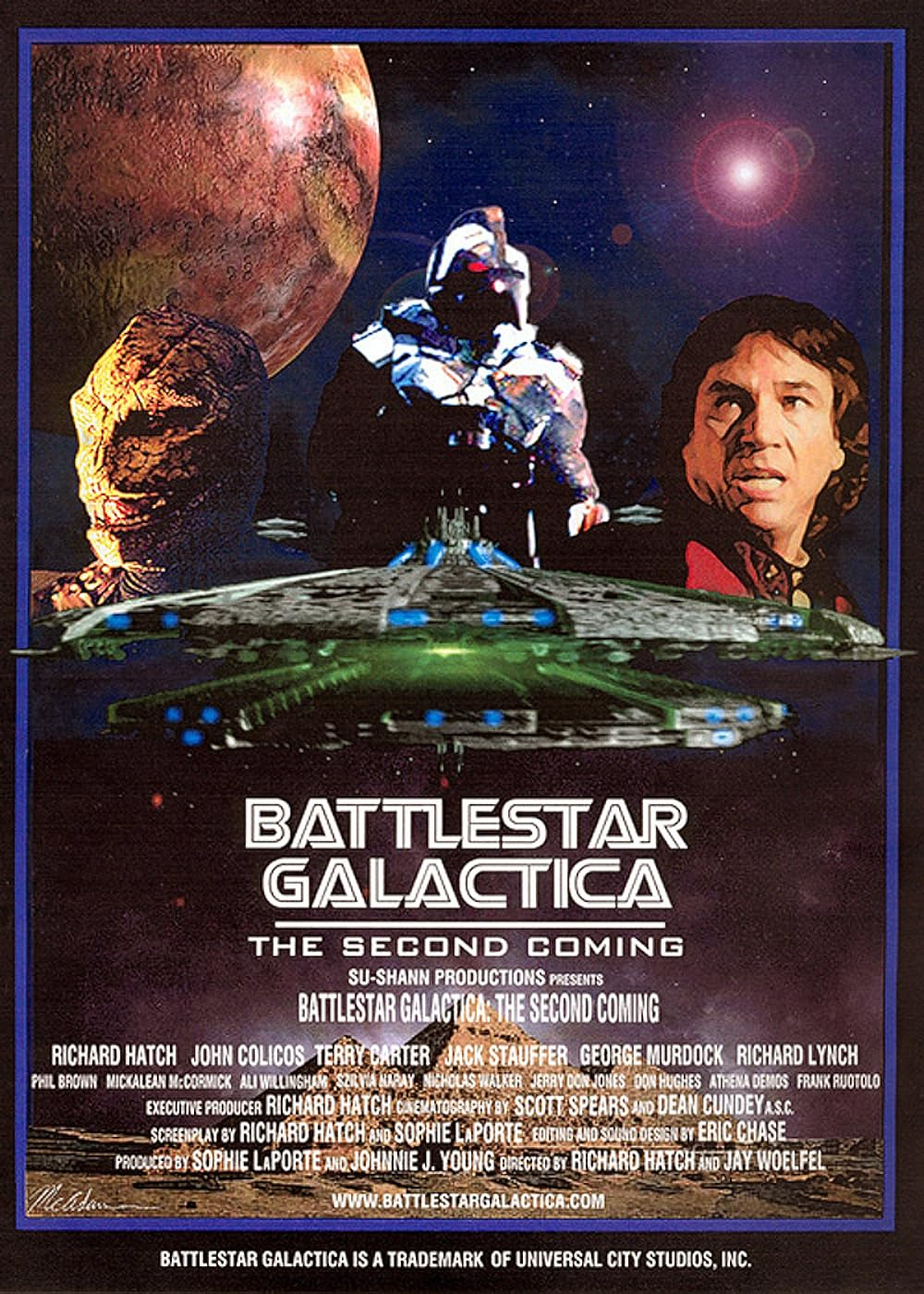
Hatch’s script, written with French producer (and then paramour) Sophie LaPorte, saw a new breed of Cylons emerge to fight a civil war with the originals, with the remnants of mankind caught in the middle of their battle. A thirty-minute short film was shot, of which only a four-minute trailer has been seen publicly, and the proposed series would have dealt with the new threat and featured a search for the missing Starbuck, Hatch obviously hopeful that his friend would pick up the phone if a series was greenlit.
Hatch toured the trailer around sci-fi conventions in 1999, hoping to catch Universal’s eye with the positive reactions he was eliciting, but Universal already ad their own plans for Battlestar Galactica underway in association with Fox and director Bryan Singer. When that project dissolved due to Fox withdrawing and Singer’s involvement in X-Men, their attention turned to Ronald D Moore, who delivered his darker reboot in 2003. Hatch eventually turned up in that series, as traitor Tom Zarek, and passed away in 2017.
Heat Vision and Jack (Fox): Wisconsin native Rob Schrab exploded onto the comic book scene with the self-published Scud the Disposable Assassin in 1994, soon earning rave reviews in the likes of Wizard magazine and catching the attention of Oliver Stone, who optioned Scud for a live-action movie in 1997. That project ultimately came to nothing and Schrab continued Scud until 1998, ending the series when he moved to Los Angeles with writing partner Dan Harmon – they were both members of Milwaukee sketch troop The Dead Alewives – in the hopes of breaking into TV.
Their spec script for BAM! (or Big Ant Movie) caught the attention of Robert Zemeckis, who signed them to a two-movie deal, although only Monster House ended up getting made, in retooled form in 2005. Such was their buzz that ABC TV also signed them to a deal, one which they found wasn’t to their liking; in order to scare the network into cancelling their agreement (or get to work on something amazing), the pair concocted their idea of the best TV show ever, which the network – predictably – passed on.
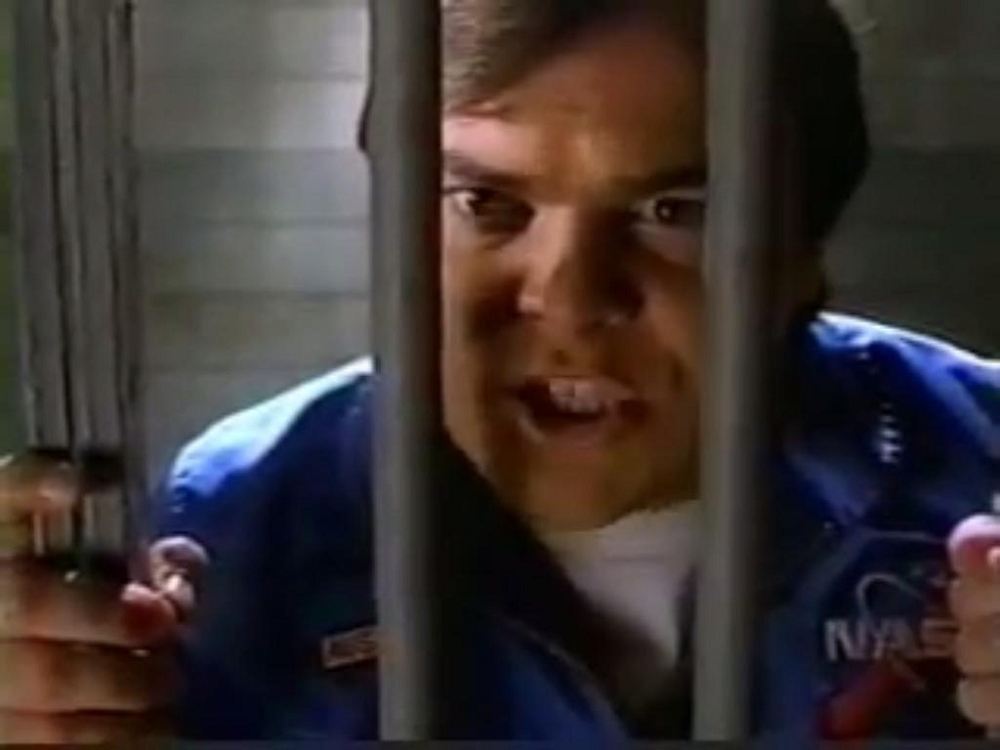
Ben Stiller, however, was impressed by their concept and talked Fox into ordering a pilot for Heat Vision and Jack, the story of a former astronaut who is exposed to dangerous amounts of solar energy, granting him super-intelligence whenever it is daylight. Heat Vision is his partner, a talking motorcycle inhabited by the spirit of Jack’s former roommate Doug, who was shot by an experimental ray gun while cleaning his bike.
Jack Black, who had yet to break through in High Fidelity, was cast as Jack, with Owen Wilson providing the voice of Heat Vision, and the cast was rounded out by Christine Taylor, Vincent Schiavelli, and Ron Silver as himself, albeit a Ron Silver who works for NASA and is impervious to harm, the villain of the piece. Heat Vision and Jack wasn’t picked up for a series, but the thirty-minute pilot has become something of a cult classic and can be freely seen on YouTube. Schrab and Harmon moved on to create Channel 101, a monthly pilot festival which gave birth to Yacht Rock, The Lonely Island, and more, a subject worthy of its own entry one day…
The Unbelievables: Ed Solomon began his writing career while still at college, selling a number of scripts to ABC for the final season of Laverne & Shirley and earning himself a place as the youngest member of the Writers Guild of America. It took a little longer for his next opportunity to arrive, hired to the writing staff of It’s Garry Shandling’s Show, during which time he met Chris Matheson and began collaborating on what would become Bill & Ted’s Excellent Adventure.
The success of Bill & Ted (and its sequel) upped Solomon’s cache and he was entrusted with the script for Super Mario Bros in 1993, a setback which took a number of years to recover from, only bouncing back with the screenplay for comic book adaptation Men in Black in 1997. In 1999, Solomon began work on a script for an alternate take on the superhero genre, focussed on retired hero Action Armstrong and his superpowered family, living a quiet life in surburbia.
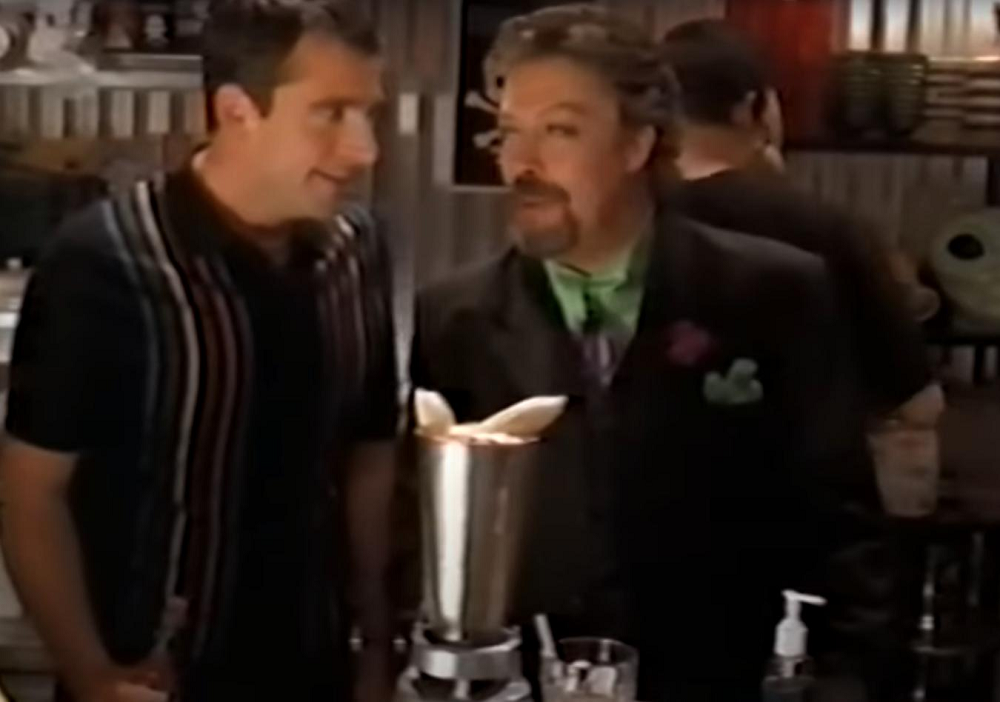
Predating Pixar’s The Incredibles by five years, The Unbelievables was being written at the same time as Mystery Men, but it was an otherwise fallow time for superhero movies, offbeat or not. Men in Black’s production company Columbia/TriStar liked the idea enough to order a pilot for the Fox network, and a twenty-three-minute introductory episode was shot with Corbin Bernsen as Armstrong, Ryan Gosling as son Josh, and Tim Curry as his former archenemy Vaudevillain, now running a bookstore.
The pilot also starred a pre-fame Steve Carrell as Vaudevillain’s sidekick Hershel, alongside Clancy Brown and Annette O’Toole as Armstrong’s ex-wife Qupid, and there’s a warmth to the show that owes as much to the charisma of it’s a-list cast as Solomon’s script. Sadly, Fox declined the show and Solomon moved on the work-for-hire of scripting McG’s Charlie’s Angels, although a low quality upload of the pilot on Dailymotion is a reminder of what could have been.
The Wonder Cabinet (Fox): Created by Glen Morgan and James Wong, The Wonder Cabinet starred Canadian actor Kim Coates as the mysterious Alvin Swissky, head of Der Wunderkammeren, a Philadelphia institute dedicated to investigating medical and biological anomalies. Back in the Age of Enlightenment, wunderkammeren were kept by wealthy men, filled with real and concocted examples of nature gone wrong, and Swissky’s institute is a modern equivalent, fearing that the likes of Ebola and AIDS may be a sign of nature fighting back.
Swissky recruits three maverick medics – heart surgeon Gordon Wayne (Space: Above and Beyond‘s James Morrison), student Sarah Coleman (Poppy Montgomery from Relativity), and unethical neurosurgeon Kevin Spitz (Currie Graham) – to join his team. Their first case is a man sharing his body with an evil conjoined twin (in the shape of a second head), the team forced to decide which one has more right to survive an operation to remove one of the heads.

The Wonder Cabinet was Morgan and Wong’s fourth attempt to parlay their success on The X-Files into a production line of their own. Space: Above and Beyond had lasted for a single season on Fox, the same network had passed on The Notorious 7, and CBS had opted not to progress bail-enforcement drama Skip Chasers to series, but there were high hopes for their latest effort, the gfreak of the week approach that had been so successful on The X- Files easily transferrable to The Wonder Cabinet’s premise.
However, despite an engaging cast and an intriguing set-up, the execution on The Wonder Cabinet left a little to be desired and Fox decided against funding a full series. Morgan and Wong were reportedly given the news during shooting of what became Final Destination, a story originally pitched as an episode of The X-Files that led to a successful career in the movies.
Next time on The Telephemera Years: Kids were still watching TV in 1999, safe from the rise of YouTube for another few years… But what were they watching?
Check out our other Telephemera articles:
The Telephemera Years: pre-1965 (part 1, 2, 3, 4)
The Telephemera Years: 1966 (part 1, 2, 3, 4)
The Telephemera Years: 1967 (part 1, 2, 3, 4)
The Telephemera Years: 1968 (part 1, 2, 3, 4)
The Telephemera Years: 1969 (part 1, 2, 3, 4)
The Telephemera Years: 1970 (part 1, 2, 3, 4)
The Telephemera Years: 1971 (part 1, 2, 3, 4)
The Telephemera Years: 1973 (part 1, 2, 3, 4)
The Telephemera Years: 1974 (part 1, 2, 3, 4, 5)
The Telephemera Years: 1975 (part 1, 2, 3, 4)
The Telephemera Years: 1977 (part 1, 2, 3, 4)
The Telephemera Years: 1978 (part 1, 2, 3, 4)
The Telephemera Years: 1980 (part 1, 2, 3, 4)
The Telephemera Years: 1981 (part 1, 2, 3, 4)
The Telephemera Years: 1982 (part 1, 2, 3, 4)
The Telephemera Years: 1983 (part 1, 2, 3, 4)
The Telephemera Years: 1984 (part 1, 2, 3, 4)
The Telephemera Years: 1986 (part 1, 2, 3, 4)
The Telephemera Years: 1987 (part 1, 2, 3, 4)
The Telephemera Years: 1989 (part 1, 2, 3, 4)
The Telephemera Years: 1990 (part 1, 2, 3, 4)
The Telephemera Years: 1992 (part 1, 2, 3, 4)
The Telephemera Years: 1995 (part 1, 2, 3, 4)
The Telephemera Years: 1997 (part 1, 2, 3, 4)
The Telephemera Years: 1998 (part 1, 2, 3, 4)
The Telephemera Years: 1999 (part 1, 2)
The Telephemera Years: 2000 (part 1, 2, 3, 4)
The Telephemera Years: 2002 (part 1, 2, 3, 4)
The Telephemera Years: 2003 (part 1, 2, 3, 4)
The Telephemera Years: 2005 (part 1, 2, 3, 4)
The Telephemera Years: 2006 (part 1, 2, 3, 4)
The Telephemera Years: 2008 (part 1, 2, 3, 4)
The Telephemera Years: O Canada! (part 1, 2, 3, 4)
Titans of Telephemera: Irwin Allen
Titans of Telephemera: Stephen J Cannell (part 1, 2, 3, 4)
Titans of Telephemera: DIC (part 1, 2)
Titans of Telephemera: Hanna-Barbera (part 1, 2, 3, 4, 5)
Titans of Telephemera: Kenneth Johnson
Titans of Telephemera: Sid & Marty Krofft
Titans of Telephemera: Glen A Larson (part 1, 2, 3, 4)
Titans of Telephemera: Quinn Martin (part 1, 2)
Titans of Telephemera: Ruby-Spears

